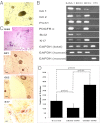CD200-expressing human basal cell carcinoma cells initiate tumor growth
- PMID: 23292936
- PMCID: PMC3557049
- DOI: 10.1073/pnas.1211655110
CD200-expressing human basal cell carcinoma cells initiate tumor growth
Abstract
Smoothened antagonists directly target the genetic basis of human basal cell carcinoma (BCC), the most common of all cancers. These drugs inhibit BCC growth, but they are not curative. Although BCC cells are monomorphic, immunofluorescence microscopy reveals a complex hierarchical pattern of growth with inward differentiation along hair follicle lineages. Most BCC cells express the transcription factor KLF4 and are committed to terminal differentiation. A small CD200(+) CD45(-) BCC subpopulation that represents 1.63 ± 1.11% of all BCC cells resides in small clusters at the tumor periphery. By using reproducible in vivo xenograft growth assays, we determined that tumor initiating cell frequencies approximate one per 1.5 million unsorted BCC cells. The CD200(+) CD45(-) BCC subpopulation recreated BCC tumor growth in vivo with typical histological architecture and expression of sonic hedgehog-regulated genes. Reproducible in vivo BCC growth was achieved with as few as 10,000 CD200(+) CD45(-) cells, representing ~1,500-fold enrichment. CD200(-) CD45(-) BCC cells were unable to form tumors. These findings establish a platform to study the effects of Smoothened antagonists on BCC tumor initiating cell and also suggest that currently available anti-CD200 therapy be considered, either as monotherapy or an adjunct to Smoothened antagonists, in the treatment of inoperable BCC.
Conflict of interest statement
The authors declare no conflict of interest.
Figures





References
-
- American Cancer Society Cancer Facts and Figures 2012. 2012. Available at: www.cancer.org/Research/CancerFactsFigures/CancerFactsFigures/cancer-fac.... Accessed March 3, 2012.
-
- Johnson RL, et al. Human homolog of patched, a candidate gene for the basal cell nevus syndrome. Science. 1996;272(5268):1668–1671. - PubMed
-
- Grachtchouk M, et al. Basal cell carcinomas in mice overexpressing Gli2 in skin. Nat Genet. 2000;24(3):216–217. - PubMed
-
- Hahn H, et al. Mutations of the human homolog of Drosophila patched in the nevoid basal cell carcinoma syndrome. Cell. 1996;85(6):841–851. - PubMed
-
- Oro AE, et al. Basal cell carcinomas in mice overexpressing sonic hedgehog. Science. 1997;276(5313):817–821. - PubMed
Publication types
MeSH terms
Substances
Grants and funding
LinkOut - more resources
Full Text Sources
Other Literature Sources
Medical
Research Materials
Miscellaneous

